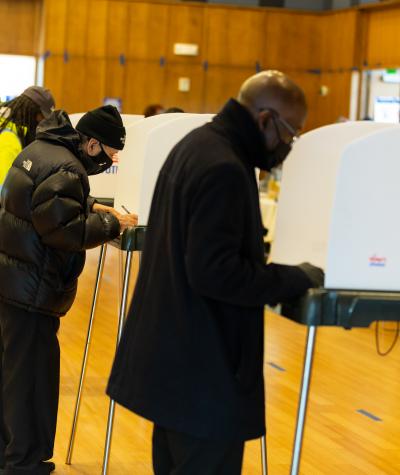By Michelle Fraling, a Summer 2021 CLC law intern
In June 2021, for the first time, New York City voters cast their ballots for mayor using ranked choice voting (RCV). RCV allows voters to rank their candidates in order of preference. When results are tallied, if none of the candidates have a majority of the first-place votes, then the votes for the candidate with the lowest amount of first-place votes are reassigned to the next-highest-ranked candidate on each voter’s ballot—so long as that candidate remains in the running—until one candidate has a majority and is declared the winner.
Despite early signs of enthusiasm, this year’s NYC primary became chaotic quickly. Following an erroneous voter tabulation announcement—in which the city’s Board of Elections released incorrect vote tallies before fixing them a day later—news outlets raised questions over the use of RCV. Specifically, political commentators questioned whether RCV was to blame for the voting debacle. But RCV wasn’t the problem; it was the NYC Board of Elections.
Tabulating the results of an RCV election is not a difficult process for modern computers; it simply requires preparation and experience. For example, every year dozens of jurisdictions use RCV without experiencing the problems observed in NYC. Moreover, several cities—including Minneapolis, MN; Portland, ME; and Santa Fe, NM—regularly use RCV for their local elections and manage to count and announce their vote tallies within the same night.
Jurisdictions typically rely on the Ranked Choice Voting Resource Center—the supplier of the RCV tabulating software—to run a parallel process to ensure that the results are accurate. The NYC Board of Elections refused this help.
Simply put, the issues with the NYC primary vote tabulation lie with the NYC Board of Elections—not with RCV. Consequently, we should not penalize RCV for the mistakes of the Board. Rather, RCV offers a host of advantages that New Yorkers will likely benefit from. For example:
RCV provides voters a more inclusive and meaningful way to express their candidate preferences. Because candidates must campaign for the first, second, and third choice of voters, candidates must appeal to a broader spectrum of voters to gain support. This in turn encourages more inclusive campaign techniques and ensures that the winner earns support from a wide cross-section of the electorate.
RCV brings more fairness to elections. As campaigns must appeal to voters who prefer other candidates, RCV removes incentives for negative campaigning. A study has shown that jurisdictions with RCV have experienced friendlier campaigns and majority support in the cities using it. For example, in the New York City mayoral race, candidates Andrew Yang and Kathryn Garcia campaigned together in the lead up to the election.
RCV reduces the spoiler effect. Despite the constant coverage over how to “game the system,” RCV eliminates the need to vote strategically. With RCV, voters do not have to worry about strategically voting for candidates that they do not like in order to avoid “throwing away” or splitting their vote. If candidate B is the voter’s favorite choice, she can vote for B without fear that her vote will be “wasted.”
RCV saves time and money for jurisdictions by eliminating the need for costly runoff elections. Runoff elections are not only expensive but also less representative. Runoff elections tend to have low and unbalanced turnout resulting in the selection of candidates who may not actually reflect voter preferences.
While it’s still too early to tell how RCV will improve NYC elections, polling suggests that RCV is at least popular among New Yorkers. According to an exit poll conducted by Edison Research for Common Cause NY and Rank the Vote NYC, 77% of NYC voters want to use RCV in future local elections, including large majorities of people across gender, age, ethnic, and borough lines. A majority of NYC voters said RCV allowed them to vote their values. And 95% of NYC voters found their RCV ballot simple to complete. This finding crossed age and ethnic lines.
Despite the chaos of this year’s NYC primary election, voters should still have faith in RCV. As we’ve seen in other jurisdictions, RCV provides voters a more inclusive campaign environment, brings more fairness to elections, and encourages a broader and more representative field of qualified candidates. Thanks to RCV, voters and candidates in NYC can be assured that the winners have broad support across the city.
